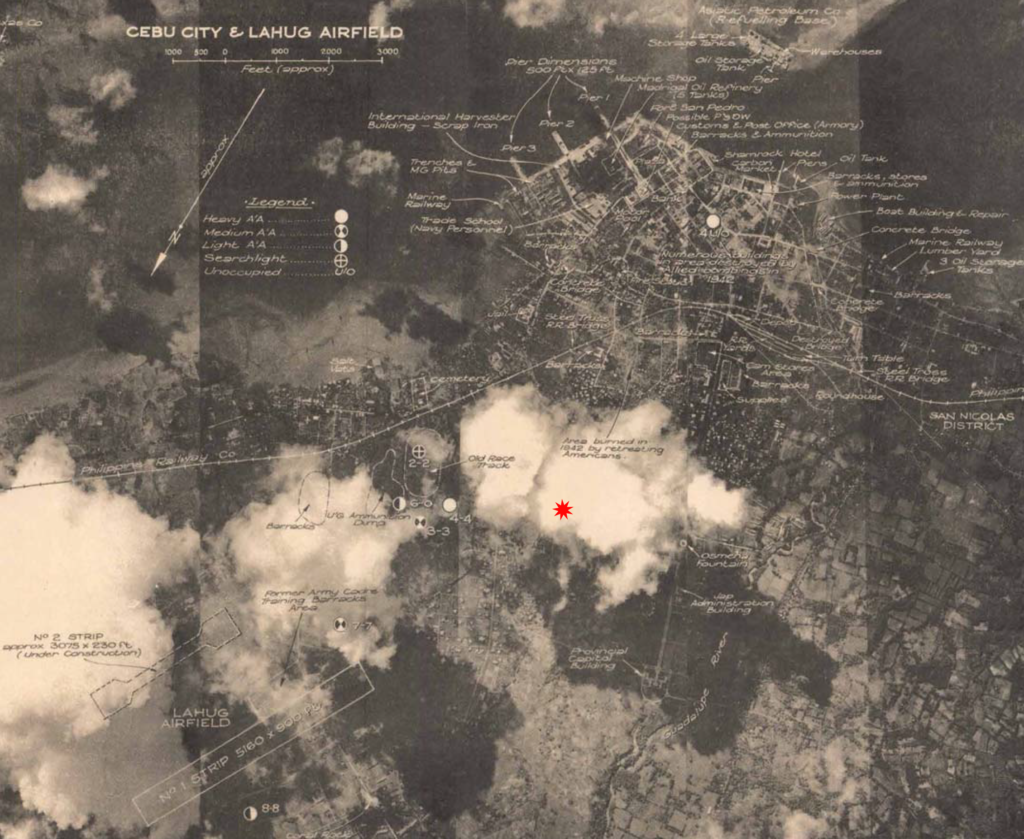An interactive map of the area and events surrounding the downing of B-25 #43-28122 on January 3, 1945. The crash site is indicated by the red/black marker and known anti-aircraft positions by orange markers.
Mid-morning on January 3, 1945, a flight of two B-25’s, led by Captain Edgar E. Girdler, attacked Lahug airdrome on Cebu Island in the Philippines. They strafed and dropped parafrag bombs as they passed along the airfield. Captain Girdler’s plane was hit by anti-aircraft fire, caught fire, went out of control, then crashed near the north edge of Cebu City. Witnesses on the other airplane stated that survival was not possible.
The 498th Bomb Squadron’s mission report is a sparse one page in length and does not provide much detail on the attack. The Missing Air Crew Report looks to be a brief, post-war version and lacks any maps or witness statements. Indorsements originating from the War Department in Washington, DC regarding the status of 2Lt Henry J. Muster, the co-pilot, are dated in June and July of 1945 and provide the details as known by subordinate units. Also included is a March 1945 letter from the US Army Americal Division relating information about the crash and identification media obtained from Filipinos who had witnessed the crash and disposition of the crew.
The indorsement from the 498th Squadron states that no one was seen to bail out of the stricken plane. The indorsement from V Bomber Command refers to details from the Americal Division letter and states that all six crew members died in the crash, the bodies were buried by Filipinos, and that five bodies were recovered by the Americal Graves Registration unit and reinterred in the USAF Cemetery #2, Cebu. The letter from the Americal Division actually says that the Filipinos claimed to have buried four bodies and recovered the dog tags of Lt. Muster and a Post Exchange card issued to Lt. Schreiber. The Filipinos reported that the crash occurred between 0700 and 0800 hours on January 3, 1945.
The Allied Geographical Section’s Terrain Study No. 100 covers the Cebu-Bohol area and provides an excellent vertical photomosaic of Cebu City that includes Lahug airdrome. Several prominent surviving landmarks, namely the Shamrock Hotel, Fort San Pedro, and the Osmeña Fountain, were used to georeference the photo to satellite imagery in order to place the two airstrips on the live map above. The positions of known A/A sites are also shown on the map.

Making several inferences from the sparse data, the flight seems to have made their run over Lahug airdrome from north to south and both planes released their bomb loads. It is about one mile from the south end of Lahug #1 to the crash site, which would have taken about 15 seconds for a plane to cover.
Apparent discrepancies are that the Filipinos claim to have buried four crewmen while the Graves Registration Unit claims to have exhumed five sets of remains. The remains of six crewmen are accounted for in three cemeteries in the US. It is likely that all the information regarding the search for and identification of the remains is not contained within the MACR.
Lost in the crash of #43-28122 were:
- Capt. Edgar E. Girdler, pilot
- 2Lt Henry J. Muster, co-pilot
- 2Lt Leslie L. Schreiber, navigator
- SSgt Mike J. Pitek, engineer
- TSgt Robert E. Harris, radio operator
- SSgt Russell H. Sweet, aerial gunner
All six of the crew are considered to have been accounted for by the DPAA. Four of the crew are interred in a group burial while two have individual graves in their home states.
